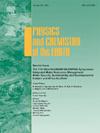沿海和海洋污染中塑料聚集体的研究:分布、可能的形成过程和分解前景
IF 3
3区 地球科学
Q2 GEOSCIENCES, MULTIDISCIPLINARY
引用次数: 0
摘要
塑料聚集体是由未使用的或废弃的塑料和天然聚集体组成的,这些聚集体最近成为主要在沿海环境中出现的现有新污染物清单的重要补充。从塑料/微塑料到塑料聚集体的转变标志着我们对塑料的理解和使用的重大转变,并促使我们重新考虑塑料的基本特征以及可能的环境威胁。塑料垃圾在进行焚烧处理时,与周围环境中存在的有机和无机物结合,形成一种新型材料。此外,一些自然因素(物理的、化学的、生物的或联合的)也作用于废弃的塑料,使其与岩石和其他土质材料结合,形成塑料集料。我们的研究旨在建立基础知识,并严格审查所有这些聚合物岩石化合物的可能形成过程,分类和可能的降解,以及它们对生态系统的影响。在未来的研究中,与这些团聚体中二次污染物的降解和释放有关的知识差距是亟待解决的问题。塑料集料的适当取样和报告程序的制定和标准化可以增进我们对其对人类健康和整个环境的影响的了解,因为这些集料含有不同的有毒化学物质。本文章由计算机程序翻译,如有差异,请以英文原文为准。

Investigation on plastic-aggregates in coastal and marine pollution: Distribution, possible formation process, and disintegration prospects
Plastic-aggregates are made up from unused or waste plastic and natural aggregates which have recently been emerged as a significant addition to the existing emerging contaminants list mainly in the coastal environment. The transformation from plastics/microplastics to Plastic-aggregates signifies a crucial shift in our understanding and use of plastics and prompting us to reconsider their fundamental characteristics along with possible environmental threats. When plastic waste is incinerated for the purpose of disposal, it combines with organic and inorganic substances present in the surrounding environment, leading to a new type of material. Besides, some natural factors (physical, chemical, biological or in combination) also act upon discarded plastics to combine with rocks and other earthen materials to form plastic-aggregates. Our research aims to build fundamental knowledge and critically review the possible formation process, classification, and possible degradation of all such polymer-rock compounds along with their impact on the ecosystem. The knowledge gap related to the degradation and release of secondary pollutants from these agglomerates is to be addressed urgently in future research. Development and standardization of proper sampling and reporting procedures for plastic-aggregates can enhance our understanding related to their impacts on human health as well as to the entire environment as these aggregates contain different toxic chemicals.
求助全文
通过发布文献求助,成功后即可免费获取论文全文。
去求助
来源期刊

Physics and Chemistry of the Earth
地学-地球科学综合
CiteScore
5.40
自引率
2.70%
发文量
176
审稿时长
31.6 weeks
期刊介绍:
Physics and Chemistry of the Earth is an international interdisciplinary journal for the rapid publication of collections of refereed communications in separate thematic issues, either stemming from scientific meetings, or, especially compiled for the occasion. There is no restriction on the length of articles published in the journal. Physics and Chemistry of the Earth incorporates the separate Parts A, B and C which existed until the end of 2001.
Please note: the Editors are unable to consider submissions that are not invited or linked to a thematic issue. Please do not submit unsolicited papers.
The journal covers the following subject areas:
-Solid Earth and Geodesy:
(geology, geochemistry, tectonophysics, seismology, volcanology, palaeomagnetism and rock magnetism, electromagnetism and potential fields, marine and environmental geosciences as well as geodesy).
-Hydrology, Oceans and Atmosphere:
(hydrology and water resources research, engineering and management, oceanography and oceanic chemistry, shelf, sea, lake and river sciences, meteorology and atmospheric sciences incl. chemistry as well as climatology and glaciology).
-Solar-Terrestrial and Planetary Science:
(solar, heliospheric and solar-planetary sciences, geology, geophysics and atmospheric sciences of planets, satellites and small bodies as well as cosmochemistry and exobiology).
 求助内容:
求助内容: 应助结果提醒方式:
应助结果提醒方式:


